Mind the Gap
Dr Jusef Kunkela's class addresses the key factors influencing the gap between preparation and restoration, as well as evaluations of milling units and milled materials.
Dr Jusef Kunkela's class addresses the key factors influencing the gap between preparation and restoration, as well as evaluations of milling units and milled materials.
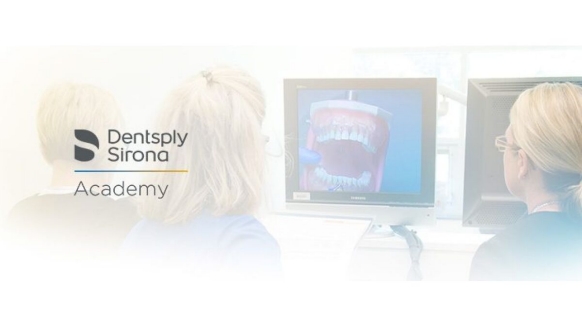
Social media marketing for dentists is growing up! And although the specific tools and tactics are always changing, the principles that drive real effectiveness remain the same. Join My Social Practice co-founder, Jack Hadley as he leads you through a lively, highly visual journey to your own practice's social media marketing nirvana. Whether you're just getting started, or you're already a social media marketing guru, you'll leave Jack's webinar with a crystal clear understanding of how social media marketing works for dental practices, along with actionable, takeaway ideas you'll use immediately in your own practice.
Course Objectives:

This program will offer timely, practical and clinically relevant information for all dentists on how to manage endodontic issues now and how you should prepare your practice to move forward in the very near future.
It will also include a review of what is and isn’t considered an endodontic emergency and which should be treated and how. There will be extensive discussion about how you, your staff and your practice should be prepared and modified to treat patients during the Covid-era and how to gain staff and patient confidence to come to work and come for treatment.
The program will also include review of careful screenings of patients pre and during visit, proper use of PPE, pre and mid treatment modifications.
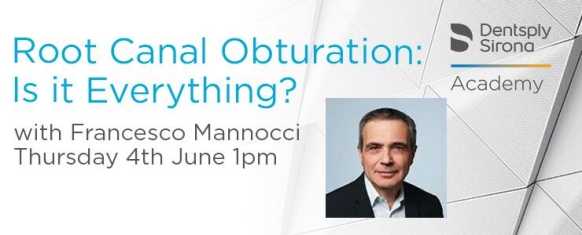
The quality of the obturation of the root canal has been found to be associated with the proportion of successful outcomes of endodontic treatments. State of the art root canal filling techniques such as the continuous wave of condensation of warm gutta-percha and cold lateral condensation are today often replaced by single cone obturation techniques combined with the use of hydraulic sealers. The aim of this lecture is to go through a series of clinical cases which will take us to clinical evidences available on the effect of new and established obturation techniques on the outcome of root canal treatments Technical aspects such as retrievability, management of obturations of curved root canals, and the challenges associated with the decrease in size of access cavities and root canal preparations will also be discussed..
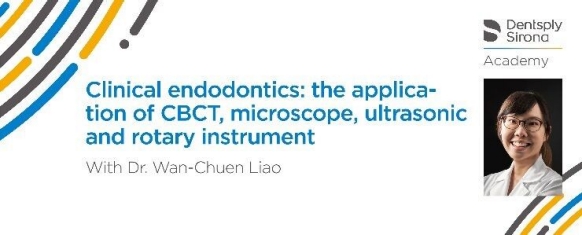
The success of root canal therapy relies on the accurate diagnosis and management. Utilize the clinical tools properly is also important. This course provides the treatment considerations of teeth with large apical lesion, calcified canal, separated instrument, c-shaped root canal system and curved canal…etc. The speaker will display microscopic video and clinical photographs. The concept and application of CBCT, microscope, ultrasonic and rotary instrument will be illustrated.

This program will offer timely, practical and clinically relevant information for all dentists on how to manage endodontic issues now and how you should prepare your practice to move forward in the very near future.
It will also include a review of what is and isn’t considered an endodontic emergency and which should be treated and how. There will be extensive discussion about how you, your staff and your practice should be prepared and modified to treat patients during the Covid-era and how to gain staff and patient confidence to come to work and come for treatment.
The program will also include review of careful screenings of patients pre and during visit, proper use of PPE, pre and mid treatment modifications.

This course will provide attendees a basic review of current pulp therapy techniques for both primary and immature permanent teeth. The topics discussed in this course include vital pulp therapy, pulpotomy, regenerative therapy, trauma, vital pulp therapy materials and behavior management of the pediatric endodontic patient. This course is a basic introduction for common issues observed in the pediatric patients of both family practice and pediatric practices.
Course Objectives:

This course will discuss commonly encountered questions from general practitioners during endodontic courses. The session will guide you through tricky situations you may encounter in your practice such as difficult diagnosis, cracked tooth syndrome, delivery of effective anesthesia and locating canals to help you to quickly and efficiently trouble shoot the problem. Effective and reliable strategies that can easily be implemented in your office will be discussed.
Course Objectives:

Dental pain is a complex and multifactorial condition that impacts all aspects of endodontic care. Explore the complexities of diagnosis and decision-making for the management of patient care before, during, and after treatment. Learn effective strategies for acute emergency care, reliable achievement of profound anaesthesia, and post-treatment pain management. Clinical cases and the latest research will be presented to hone our understanding in this area and build upon the endodontic skill-set.
Course Objectives:

The most recent advances in canal preparation methods have focused on the concept that less is more. Dr. Ruddle will describe a state-of-the-art single-file method for glide path management and shaping canals, regardless of their length, diameter, and curvature. Emphasis will be on how the convergence of file design, heat treatment technology, and a unique movement significantly improve safety, efficiency, and simplicity when shaping canals. Well-prepared canals promote 3-D disinfection and filling root canal systems.
Course Objectives:

Nickel Titanium instruments come in a variety of configurations. But regardless of the system to be used, the first step is always the same; create a glide path. The development of a good glide path is mandatory for the safe use of NiTi shaping files. Dr. Manor Haas walks you through the steps he uses to complete a good glide path. In addition, Dr. Haas offers several other key concepts which are a part of good endodontic practice.
Course Objectives:

Modern technology, ergonomics and efficiency take center stage as Dr. Tom McClammy helps clinicians seeking “the thrill of the fill." Both the general practitioner and the seasoned endodontist will appreciate the techniques presented for both clinician and chair side assistant. Course Objectives: Review important fundamental principles of shaping and cleaning the root canal system that are mandatory prerequisites for optimal obturation. Introduce an efficient reliable means to create 3D obturation of the root canal system with warm gutta-percha. Share and illustrate nuances in warm gutta-percha obturation techniques that aid clinicians and chair side assistants in capturing more root canal anatomy than previously thought possible.

In this webinar, Dr. Manor Haas walks the viewer through the side-by-side comparison of traditional warm downpack and carrier-based obturation. He discusses each step of both techniques, provides clinical tips and discusses misconceptions about carrier-based obturation. New materials and good engineering provide systems that provide fewer steps, are more predictable and leave less room for error. Watch Dr. Haas show how each of these attributes work together to make obturation more successful and less stressful!
Course Objectives:

It has long been the goal of endodontic therapy to eliminate the bacteria which cause infection and encourage a natural healing response in the body. Mechanical debridement is one step toward this end game. But the real key, according to Dr. Donnie Luper, a practicing endodontist, is the irrigation protocol. The old adage of instruments shape and irrigants clean is as true today as it ever was. In this presentation, Dr. Luper will address both the why and the how when it comes to canal disinfection. Course Objectives: Identify and discuss the different steps in a modern endodontic irrigation protocol. Discuss the reasons for activation of irrigants during the irrigation phase of endodontic therapy. Identify situations where a two-visit disinfection process may be advantageous.

Endodontic success is dependent on a variety of interrelated factors, but removal of bacteria from the root canal system is the ultimate goal. It is imperative that all canals are located and cleaned to the root apex to achieve maximum disinfection. This session will place special emphasis on locating canals and the anatomical complexities that impact clinical outcomes. Enhanced irrigation protocols will be explored along with state of the art obturation techniques.
Course Objectives:

In this webinar, Dr. Gary Glassman walks through an overview of both the business and technics of providing endodontic care predictably, profitably and painlessly. From CBCT to common troubleshooting, all things combine to bring together successful root canal treatment that provides quality treatment, predictable outcomes and optimal patient care. Dr. Glassman has easy, key takeaways that enable the clinician to optimize their time, all while improving their technique and outcome. From shaping the canals he can find, to backing the file out, Dr. Glassman will keep you engaged and encouraged!
Click here to learn more and register

Without accurate diagnosis the subsequent steps in endodontics are doomed to failure. Even the most skillful treatment is useless if performed on the wrong tooth. Dr. Natanya Padachey discusses navigating the sometimes difficult waters of diagnosis and treatment planning. This program will delve into the science and technology involved. Dr. Padachey will also suggest a basic framework for a good endodontic diagnostic process.
Course Objectives:
Click here to learn more and register

Dr. Scott Resnick, a leading endodontist with New York City Endodontics, outlines the important steps in successful endodontic treatment. He guides the participant through the steps in endodontics, intricately tying each step into meeting the main goal of root canal therapy: the prevention and or elimination of bacterial infection and inflammation associated with the canal system. His approach is clear and logical as he paints the picture of canal anatomy and how to successfully treat it in its entirety. Course Objectives: Recognize how our advanced technology provides greater clinical ease and outcomes in the various endodontic steps Appreciate the anatomy and complexity of the canal system and how CBCT and microscopes play an important part in successful treatment Review the importance of straight-line access, ultrasonics, employing proper apex locator techniques and creating a smooth and reproducible glide path Identify how the reciprocating motion reduces stress in the canal Gain a better understanding of irrigating solutions, activation and how flowable gutta percha 3-dimensionally seals the complex anatomy.

Endodontic therapy has evolved because of our clearer understanding of stress distribution in dental supporting structures and how to restore the endodontically treated tooth. This webinar will review final restorative goals and how instrumentation and canal preparation may impact the survival and life cycle of a tooth.
Course Objectives:

Learn how to navigate the most profitable procedure in dentistry with 3D imaging. Many dentists are under utilizing their cone beam when in actuality they can enhance diagnostic and clinical endodontics skills. This webinar will guide you through the advantages of using cone beam in case selection to help increase productivity, positive outcome, and your bottom line.
Course Objectives:

This 2-part continuum focuses on the ultimate goal of the single visit Endo/Resto appointment: preservation and extension of the tooth life cycle. Participants will learn how to increase predictability and long-term success using the latest endodontic and restorative technologies, trends and techniques. This course will also reinforce the importance of reviewing operatory utilization and the value of combining Endo/Resto into a single visit appointment that preserves the natural dentition, provides exceptional service to the patient, and improves practice profitability.
Course Objectives:

This 2-part continuum focuses on the ultimate goal of the single visit Endo/Resto appointment: preservation and extension of the tooth life cycle. Participants will learn how to increase predictability and long-term success using the latest endodontic and restorative technologies, trends and techniques. This course will also reinforce the importance of reviewing operatory utilization and the value of combining Endo/Resto into a single visit appointment that preserves the natural dentition, provides exceptional service to the patient, and improves practice profitability.
Course Objectives:

A single visit root canal therapy is one of the most profitable procedures in dentistry. It is also a great practice builder. This course will define which cases will make you look like a rock star in front of your patients and be profitable at the same time.
Course Objectives:

Root canal therapy can be very rewarding for that dentist and patient. Pitfalls and mistakes can occur at several stages during treatment. Join me in finding our how to avoid them, and if they occur how to deal with difficult situations.
Course Objectives:

Dr. Sergio Kuttler, a long-time educator, researcher and clinician; and co-founder of the International Endodontic Institute, discusses the latest advancements in root canal instrumentation as well as the underlying philosophies that influence current instrument design.
Course Objectives: Characterize and discuss recent research as it relates to apical root canal sizing. Describe the effect of instrument design and clinical applications that enhance performance and safety and reduce the incidence of failure. Describe and discuss the latest concepts in reciprocating root canal instrumentation and differentiate these concepts from those that relate to rotary instruments.

Dr. Cliff Ruddle provides concepts, strategies and techniques for glide path management and shaping canals, focusing on recent advancements that are redefining the world of rotary shaping by feeling and seeing unprecedented control, confidence and predictability that will resonate with all dentists. Course Objectives: The Importance of Access. Scouting & Sequencing the Preparation. Glide Path Management and Shaping. Finishing for Success

Understanding canal morphology is a critical component of successfully performing endodontic access on posterior teeth. Dr. Troy McGrew, a board-certified endodontist, shows us how posterior teeth should be opened and how that impacts the subsequent shaping and cleaning of the canal spaces. Dr. McGrew will explain methods for determining the depth of the pulp chamber via radiography and how that information plays into the access equation. He will address the most frequently occurring issues when performing access and how to avoid those errors. Dr. McGrew will also offer several hints which can guide the clinician towards a complete endodontic access.
Course Objectives:

Prevention of re-infection is the purpose of endodontic obturation. And over the years a number of materials and techniques have been used in the attempt. Some have proven more successful than others in how well they seal. But the steps required can be daunting. Dr. Mike Nimmich is an endodontist who has tried a number of techniques over the course of his long and varied career. In this presentation Dr. Nimmich will review the requirements for an acceptable obturation technique and the materials to be employed. He’ll also demonstrate how a core carrier technique utilizing a novel configuration of gutta-percha can meet the well-established procedural goals as well as current clinical needs in a variety of situations.
Course Objectives:

The trends in endodontic treatment are leaning heavily towards fewer steps and simplification while still providing better predictability for clinicians and the best possible outcomes for our patients. While innovations are plentiful in the file category, obturation in root canal therapy is similarly advancing to benefit both clinician and patient. Dr Manor Haas, a certified Endodontist, relates his experience amongst the various methods of obturation and shares with clinicians many practical tips on succeeding with obturation.
Course Objectives:
Social media has become the core of all digital efforts for attracting new patients. But many practices still struggle with knowing what's most effective. And, in addition to attracting new patients, smart practices are using social media to raise top-of-mind awareness, increase word-of mouth referrals, decrease attrition through strengthened patient relationships, and boost case acceptance. How do you find the time to be effective when you're running a busy practice? Join My Social Practice co-founder, Jack Hadley as he outlines a plan of action that makes social media management for you and your team.
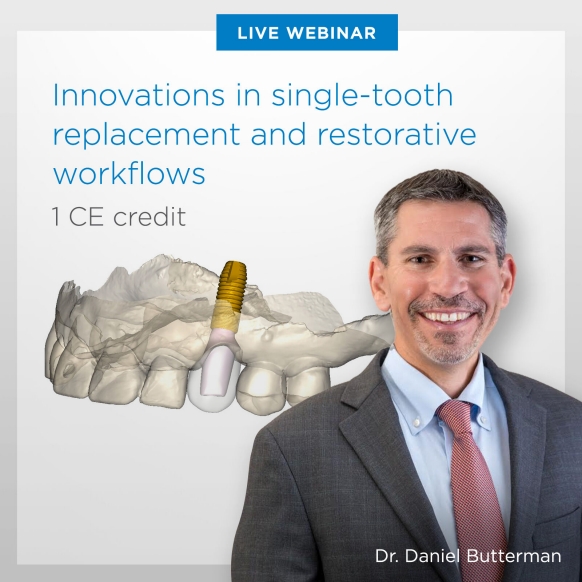
Webinar with Dr. Daniel Butterman
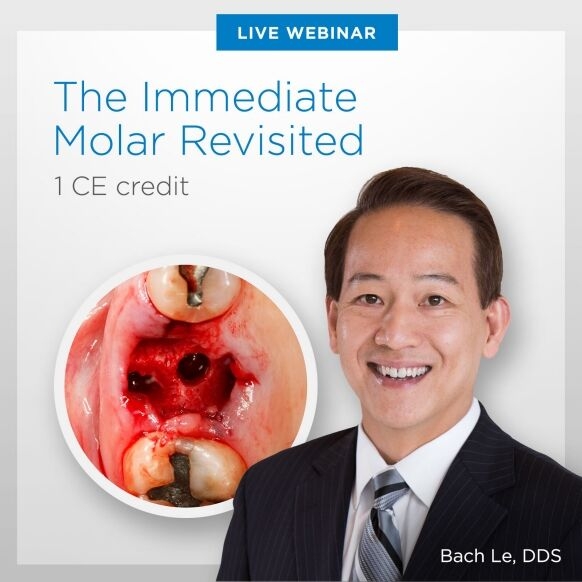
Dr. Bach Le covers the numerous factors to consider when immediately placing an implant in a molar extraction site, e.g. what diameter implant to use and how to optimize positioning in multi-rooted sockets.
Click here to view
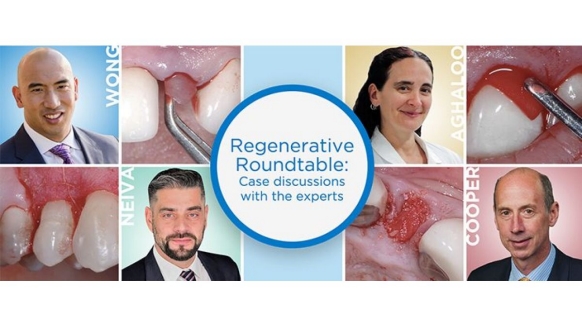
Join Drs. Tara Aghaloo, Lyndon Cooper, Rodrigo Neiva and David Wong for this interactive webinar.
The era of placing implants with disregard to esthetic outcomes is over. Patients are demanding function and esthetics. Treating sites with soft and hard tissue loss may be challenging, but is often necessary to ensure a successful outcome and meet patient expectations. During this regenerative focused roundtable discussion, the experts will present cases and discuss different treatment options, including the importance of implant design, graft material selection and application.
At the completion of this course, participants will be able to understand:
- The importance of graft material selection for stable outcomes
- How graft material selection may affect implant success
- Contemporary surgical techniques to maximize outcomes
- When it is necessary to consider soft and/or hard tissue grafting for optimal dental implant esthetics.
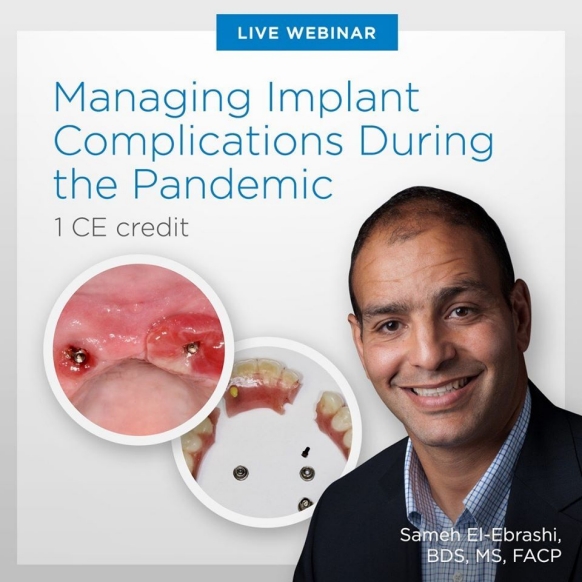
What do you do when a patient calls with an implant complication during lockdown? Dr. Sameh El-Ebrashi discusses proper triaging of patients, extra precautions needed, and more in this free live webinar..
Click here to view
Webinar arranged by Datum Dental.
Webinar arranged by Datum Dental.
Webinar arranged by Datum Dental.
Webinar arranged by Datum Dental.
Webinar arranged by Datum Dental.

Aerosol generation and its associated health risks to dental professionals has been researched since the 1950s. The recent pandemic has brought increased awareness to this invisible villain, but fear and abandonment of evidence-based therapies which are essential to patient care should not be a solution. Ultrasonic instrumentation is the current standard of care for periodontal debridement, and this course will explore the science long established around how to maximize a safe working environment while using this technology.

You may be surprised to find that a simple technique such as light-curing can have a wide impact on common restorative materials. This program is designed to help you gain a better understanding of all the factors that affect light curing as well as optimize your light-curing technique to achieve better clinical outcomes.

Our reputation as dentists in delivering esthetic and restorative dentistry is directly dependent upon adhesion! Whether it be direct or indirect, adhesion is the foundation for the success of long-term dental restorations. An understanding of the different categories of adhesives on the market is the cornerstone to successful and long-lasting restorative outcomes.
Learning Objectives:

We will explore a six-step approach to simplifying and streamlining your posterior composite technique that can give you and your patients high quality, reproducible results and make your practice more profitable!
Course Objectives:
We all know the adage “a picture is worth a thousand words”. In modern day dentistry, this phrase is more true than ever. Dr. Campbell will cover camera selection and settings, a standard photographic series, and how to use photography as an integral part of everyday practice. Photography is not just for “big esthetic cases” anymore but is an indispensable tool that will elevate your practice and improve patient care. He will also use photography to illustrate some “can’t miss” restorative pearls that will help simplify many procedures and enhance restorative excellence
Course Objectives:
Topics to be covered include:
The diversity of restoration material on the market make it difficult for dentists to determine the ideal material choice for direct restoration of post endodontic treatment.
It starts by defining tooth surface loss and the different types, then how we detect and measure it, how we look at risk factors, how we reduce then impact, and then how we manage it. ELOs: - Describe the erosive process in the context of tooth surface loss - Discuss how the effects of TSL can be limited - Discuss materials for the use of direct restoration of erosion cases.
In this 1 hour webinar, Dr. Ian Cline will share his thought and experiences of using this technique for over 20 years in his clinic. Aims and objectives: Understand the multifactorial nature of tooth surface loss, Diagnose & create a treatment plan for the worn anterior dentition, What does the literature say about the use of the Dahl concept, The importance of patient communication with this approach to treatment, Step by step “Dahl buildups”, which type of cases should you tackle first? Common mistakes and how to best manage them, Longevity and maintenance of your cases.
Click here to learn more and register